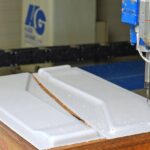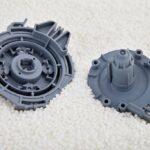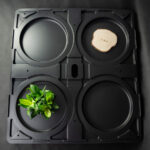Plastics are an integral part of modern industry a Among transparent materials, the most common choices are two popular polymers - Plexiglas (PMMA) and polycarbonate (PC). At first glance, they look similar. Both are lightweight, colorless and resemble glass. However, their physical and mechanical properties, resistance to external conditions, and range of applications are significant. What to choose when safety and durability are important, and when it is worth betting on aesthetics and perfect transparency? Learn about the key differences and practical examples of Plexiglas and polycarbonate applications.
Plexiglas (PMMA) - an excellent alternative to glass
Plexiglass, also known as acrylic glass or PMMA, is a material distinguished by its very high transparency, reaching up to 92% of light transmission. This makes the material an attractive alternative to traditional glass. In addition, it is lighter and easier to process. It can be cut, bent or milled, which gives designers a lot of freedom.
Why should you consider Plexiglas in your project? Learn about its key properties that can translate into safety, functionality and cost optimization in industrial and architectural projects.
Key properties of plexiglass
Plexiglass is a lightweight material, easy to process, and resistant to external conditions, which makes it widely used in many industries. What sets it apart?
1. very high transparency (even 92% light transmission)
Interestingly, Plexiglas transmits even more light than glass, thus guaranteeing exceptional clarity and aesthetics. This makes it often used where appearance and visual effect are crucial.
2. resistance to UV radiation (does not yellow in the sun)
Thanks to its resistance to UV rays, plexiglass retains its transparency and does not change color, and this is true even during years of outdoor exposure.
3. resistance to weather conditions (rain, humidity, changing temperatures)
Plexiglas stands up well to rain, moisture and varying temperatures, so it can be safely used outdoors without the risk of mechanical and visual deterioration.
4 Less weight compared to glass (easier to transport and install)
It is about twice as light as glass of the same thickness, which makes it easier to transport, install and reduces the load on the structures in which it is used.
5. thermoformability (easy shaping under heat)
Under the influence of heat, Plexiglas can be freely molded, making it possible to create elements with different shapes and bending radii in a single production process.
6. possibility of processing (cutting, bending, milling)
Plexiglas is easy to machine. It can be cut, bent and milled using standard tools, which significantly speeds up the production process.
7. good acoustic and thermal insulation
The material has insulating properties, so it can be used in structures that require noise attenuation or reduced heat loss.
8 Safe for food contact, non-toxic
Plexiglas is a non-toxic material and safe in contact with food, which allows it to be used also in the food and catering industry.
Disadvantages of Plexiglas - when will it not work for your project?
Plexiglas, despite its many advantages, also has some limitations. These are worth taking into account at the design stage.
1. lower impact resistance than polycarbonate
Compared to polycarbonate, Plexiglas is more brittle and less resistant to strong impacts, so it is not used where mechanical safety is crucial.
2. susceptibility to scratching (especially high-gloss surfaces)
Plexiglas scratches easily, so in areas exposed to frequent contact it is recommended to use special protective coatings or choose polycarbonate.
In such cases, polycarbonate may be a better choice, especially where mechanical resistance and safety of use are key. So if you're designing machine guards, protective partitions or impact-prone components, or outdoor structures that need to withstand mechanical loads and strong impacts, polycarbonate will provide many times the strength of Plexiglas.
Polycarbonate (PC) - high resistance and safety
Polycarbonate is a material valued primarily for its exceptional impact resistance and mechanical strength. Although it transmits slightly less light than Plexiglas, it still retains very good transparency and aesthetic appearance. Why use polycarbonate in your project?
Key properties of polycarbonate
Polycarbonate is a versatile, durable and resistant to mechanical damage material, so it is used in projects requiring the highest safety parameters. What are its characteristics?
1. very high impact resistance
Polycarbonate is up to 200 times more impact resistant than glass of the same thickness, while Plexiglas has a resistance about 10 times higher than glass, but remains a brittle material compared to polycarbonate. Therefore, polycarbonate is used in structures where the safety of users and durability under mechanical loads are priorities.
2. good transparency (about 86-89% light transmission).
Although the transparency is slightly lower than that of Plexiglas, polycarbonate still provides high clarity and aesthetics, allowing it to be used in glazing and shielding requiring transparency.
3. resistance to high temperatures (up to 120°C)
Polycarbonate retains its mechanical properties at temperatures much higher than Plexiglas, allowing it to be used in structures exposed to heat. By comparison, Plexiglas can withstand service temperatures up to about 80°C, above which it can deform or lose its mechanical properties.
4. possibility of cold bending
Unlike Plexiglas, polycarbonate can be molded without heating, which greatly speeds up the assembly process and gives greater design flexibility.
5. weather and UV resistance (with UV stabilization)
Polycarbonate withstands outdoor conditions well, but requires UV stabilization for outdoor applications to maintain its optical and mechanical properties.
6 High scratch resistance (compared to Plexiglas)
Although polycarbonate can also be subject to scratches, it is more durable than Plexiglas in this regard and is better suited for areas exposed to frequent contact.
7. lightweight construction
Like Plexiglas, polycarbonate is about twice as light as glass, making it easier to install and reducing the load on the structure.
Disadvantages of polycarbonate - when will this material not work in your project?
Polycarbonate, like any plastic, also has its limitations. So when might it not be the best choice?
1. higher price compared to plexiglass
Polycarbonate is more expensive than Plexiglas, which can affect the project budget, especially for large areas.
2. polycarbonate requires UV stabilization when used outdoors
Without additional UV stabilization, polycarbonate can lose its optical properties over time, so choose versions with UV protection for outdoor projects.
While these drawbacks may be significant in some projects, in most industrial and structural applications polycarbonate remains irreplaceable due to its exceptional durability and safety in use.
Examples of Plexiglas and polycarbonate applications in industry
Both Plexiglas and polycarbonate are two of the most widely used transparent plastics in industry. Although the two materials look similar, they differ in their properties and range of applications. Plexiglass is chosen where aesthetics, high transparency and lightweight construction are key, while polycarbonate is used wherever the highest mechanical resistance is required.
Examples of the use of polycarbonate in practice
Polycarbonate is a material that is used in many industries due to its exceptional mechanical resistance and high transparency. Geo Globe Poland has a special focus on its use in construction.
One of the key products is thermoformable roof domes and skylights. The polycarbonate domes we make are characterized by the highest degree of transparency and precision manufacturing.
Polycarbonate domes stored at Geo Globe Poland's facility before delivery to customers.
Thermoforming machine in the machinery park of Geo Globe Poland - the process of manufacturing polycarbonate roof domes and skylights with high transparency and precision.
The use of polycarbonate in practice
☑ Construction and architecture - Skylights, domes, terrace and entrance canopies, facades, bus shelters;
☑ Machinery industry and manufacturing - Machine and equipment covers, protective covers in production halls and warehouses;
☑ Transportation and automotive - burglar-proof glass, operator booth covers, structural components in vehicles and public transportation;
☑ Sports and recreation - Glazing and shielding in sports halls, ice rinks, recreational facilities.
Examples of the use of Plexiglas in practice
☑ Architecture and construction
In the construction industry, Plexiglas is used to create partitions and fill balustrades, canopies, entrance canopies and wind screens. The lightness and aesthetic appearance of the material allow to design modern structures that do not weigh down the building.
☑ Food and medical industry
Due to its non-toxicity and safety in contact with food, plexiglass is used in the production of hygienic covers, partitions, containers and elements of equipment for laboratories and medical facilities.
☑ Machinery industry and manufacturing
In industrial plants, plexiglass is used to build machine and equipment covers in areas where there is no high risk of impact, and visibility of technological processes and aesthetics of workstations are important.
Not sure which material will work best for your project? Consult with the experts of Geo Globe Poland. We will help you choose the best solution.
Check: https://www.geoglobe.pl/geokrata-na-skarpy-o-wysokosci-5-cm-10-cm-czy-15-cm-jaka-wybrac/
Do you have a design challenge? Contact our team - we will advise and propose a solution tailored to the conditions of your project.
Follow us on social media
You may also be interested in:
- Understanding CNC machines: What should you know about their operation and benefits?Is it possible to produce quickly, precisely and without any worries about repeatability? CNC machines make what used to require the hand of a master and many hours of adjusting, happen today in an automated, controlled and predictable way. After all, CNC machines work on projects where accuracy to tenths of a millimeter counts, as well as full control over every stage of machining. But how does this technology actually work, and why should it be used in the production of plastic components?
- The use of plastics in industryDo you know what the bottle of the iconic Family Shampoo has in common with the engine cover on a Tesla Model 3? Well, more than you might expect. Plastics today play a key role in modern industrial processes - from everyday objects to high-tech components used in automotive, aerospace and construction. Their versatility and innovation are second to none. ...
- Plastic Moldings and Thermoformed Extrusions: Advantages and Applicability in Various IndustriesIt's hard to find an industry today that doesn't need a precision-engineered, lightweight yet durable plastic component. From delicate blisters in pharmaceuticals, to transport trays on automotive lines, to ESD anti-static extrusions to protect electronics during manufacturing and logistics, thermoformed extrusions are popping up everywhere.
- Vice President Dobrochna Kochanska an official member of the Business Center ClubVice President Dobrochna Kochanska an official member of the Business Center Club

















